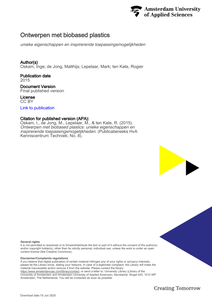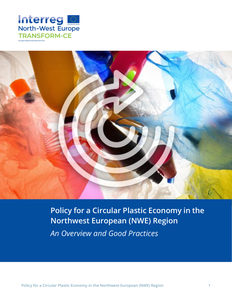‘Ontwerpen met biobased plastics’ is de eindpublicatie van het project “Design Challenges with Biobased Plastics”. In dit onderzoeksproject deed de HvA, samen met diverse mkb-bedrijven onderzoek naar de kennis een tools die ontwerpers nodig hebben om biobased plastics, kunststoffen van hernieuwbare materialen, toe te passen. De publicatie gaat in op de kansen die biobased plastics bieden en biedt praktische tools, inspirerende voorbeelden en handreikingen die het ontwerpen met deze materialen makkelijker maken.
DOCUMENT

Om de toepassing van biobased plastics te stimuleren is een belangrijke rol weggelegd voor ontwerpers. Omdat zowel gevestigdeontwerpers als studenten weinig tot geen kennis hebben van biobased plastics, doet de Hogeschool van Amsterdam (HvA) onderzoek naar verschillende aspecten van ontwerpen met biobased plastics.
MULTIFILE

Producten van biobased kunststoffen, worden vaak via logo’s herkenbaar gemaakt. Consumenten zien echter door de bomen het bos niet meer. Manouk van der Wal heeft onderzocht of dit niet anders kan. Is het mogelijk om voor ontwerpers ontwerpregels voor biobased producten te ontwikkelen? Zodat deze producten zelf zeggen: ‘Ik ben gemaakt van biobased plastic!’ Dit artikel is de tweede van een reeks van vier artikelen die in Product Magazine verschenen.
DOCUMENT
DOCUMENT

Worldwide, plastic cups are used for serving drinks. Some typical examples of large-scale consumption are large concerts and festivals. As a part of the BIOCAS project, which focusses on the valorization of biomass through various routes, a PHA biobased festival cup was developed and created to reduce the impact of current fossil plastics. The role of VHL was to assess the environmental impact. The aim of the report is to inform the BIOCAS-partners about the use of plastic cups, and address the environmental impact in comparison with other types of biobased plastic cups and fossil-based cups. This report can serve as a basis for making choices within all different types of (plastic/biobased) cups. Besides, it can be used as a public communication tool about the environmental impact of different types of (plastic/biobased) cup applications.
DOCUMENT

In het project Circulaire Biopolymerenwaardeketens voor PHA en cellulose wil men naar afbreekbare en biogebaseerde plastics, producten en afzetmarkten toe. Kansloos als die nieuwe plastics moeten gaan concurreren met oliegebaseerde plastics die al in grote hoeveelheden worden geproduceerd; kansrijk als die plastics toegevoegde waarde bieden en het productieproces ervan een hoge theoretische en praktische opbrengst heeft.
LINK
Dit boek is het resultaat van het SIA Raak MKB project “Biocomposieten voor civiele en bouwkundige toepassingen; Biobased brug”. Het is geschreven voor bedrijfsleven en studenten van het MBO, het HBO en de universiteiten. Het project leverde een haalbaarheidsonderzoek van een volledig biocomposieten voetgangersbrug. Materialenonderzoek bij Inholland Composites en stijfheid en sterkte berekeningen toonden aan dat een volledig biocomposieten voetgangersbrug haalbaar was. De Dommelbrug is met succes door ruim 100 studenten gebouwd.
DOCUMENT

Positioning paper bij de inauguratie van Vincent Voet als lector Circular Plastics.
DOCUMENT
![People. Planet. Polymer: een Wereld te Winnen [Inaugurele rede]](https://publinova-harvester-content-prod.s3.amazonaws.com/thumbnails/files/previews/pdf/20250506132442742072.Positioning20Paper20Vincent20Voet202024-thumbnail-400x300.png)
Plastic is one of the biggest contributors to pollution of the planet. Due to the low recyclability of oil-based plastics, most plastic is being disposed into the environment. According to plastic oceans, 10 million tons of plastic are dumped into oceans annually. Currently, researchers are developing recycling methods for oil-based plastics and are looking for biobased alternatives. One of these alternatives are a class of polymers called polyhydroxyalkanoates (PHA’s). PHA’s differ from other biobased polymers, due to the process of fabrication. PHA’s are a natural polymer, acting as an energy and carbon storage for different strains of bacteria. Functioning as an energy storage, nature can break down PHA’s and PHA-based waste. (1) Different companies are working on PHA’s production, but a large deviations in physical properties were observed. This research aims to establish a relationship between the chemical and physical properties of the different PHA’s, using gel permeability chromatography (GPC), nuclear magnetic resonance (NMR) and gas chromatography-mass spectroscopy (GC-MS).
DOCUMENT
This document combines four reports on existing regional business support programmes for inclusion or understanding of circular economy (CE) objectives, deliverable DT3.1.2 from the transform-CE project. Besides a general overview on national and regional level, the focus is on a selection of national and regional programmes aimed at the plastics industry. After explaining the format to structure the programmes, the results for the four regions are presented: Greater Manchester (UK), Rhineland Palatinate and North-Rhine Westphalia (DE), Wallonia (BE), Central Netherlands (NL).
MULTIFILE
